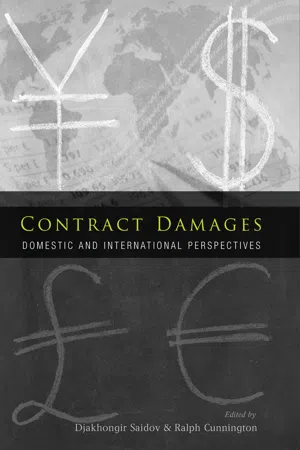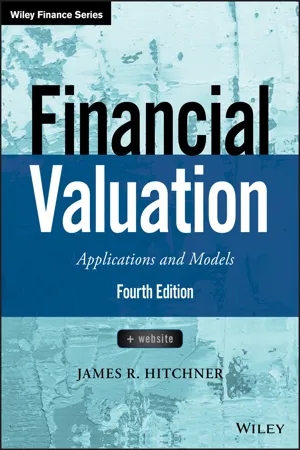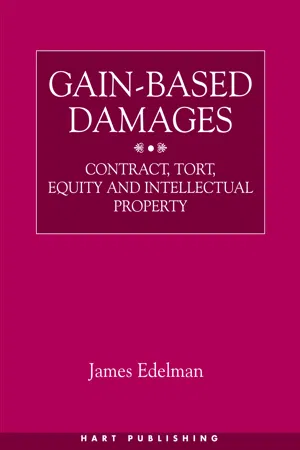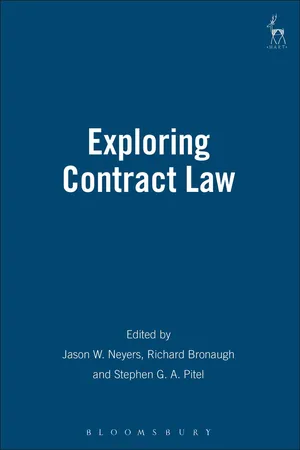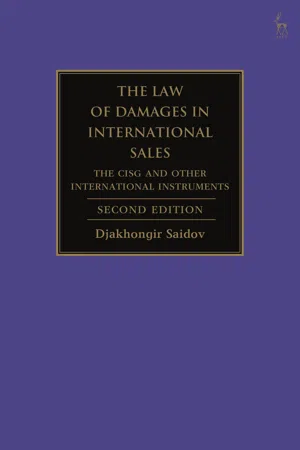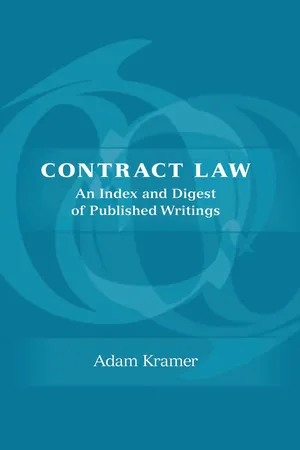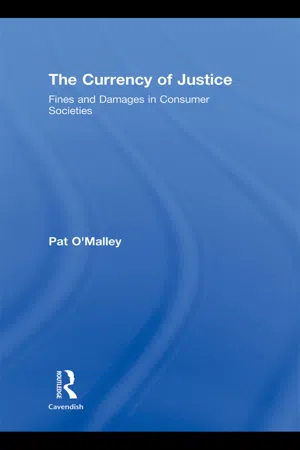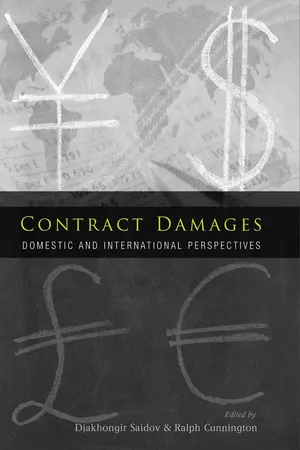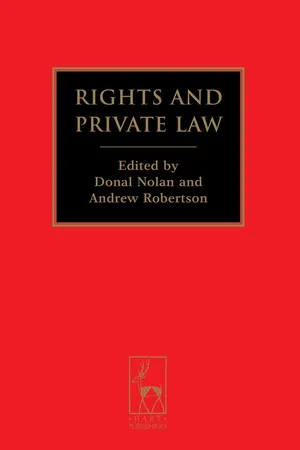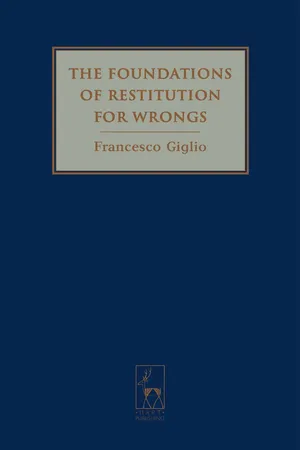Law
Damages
Damages refer to the monetary compensation awarded to a party who has suffered loss or injury due to the wrongful act of another party. In legal terms, damages can be categorized as compensatory (aimed at compensating the injured party for their loss) or punitive (intended to punish the wrongdoer). The purpose of damages is to provide a remedy for the harm caused.
Written by Perlego with AI-assistance
Related key terms
1 of 5
11 Key excerpts on "Damages"
- eBook - ePub
Contract Damages
Domestic and International Perspectives
- Djakhongir Saidov, Ralph Cunnington, Djakhongir Saidov, Ralph Cunnington(Authors)
- 2008(Publication Date)
- Hart Publishing(Publisher)
A similar observation could be made of Damages law in civilian regimes although the explanation of how and why Damages law is not well-understood differs. 4 See, eg Weinrib (1995), above n 2; Coleman, above n 2; Goetz and Scott, above n 2; Craswell, above n 2. 5 See, eg Law Commission Report No 247, Aggravated, Exemplary and Restitutionary Damages (1997); G Jones, ‘The Recovery of Benefits Gained From a Breach of Contract’ (1983) 99 LQR 443; J Stapleton, ‘Negligent Values and Falls in the Property Market’ (1997) 113 LQR 1. 6 Important exceptions include R Zakrzewski, Remedies Reclassified (Oxford University Press, 2005) 165–79 and D Friedmann, ‘Rights and Remedies’ in N Cohen and E McKendrick (eds), Comparative Remedies for Breach of Contract (Oxford, Hart Publishing, 2005). 7 The importance of analytic questions about Damages is discussed in more detail below in section VI. 8 Except where otherwise indicated, ‘Damages’ refers to Damages orders in general and not just Damages orders for breach of contract. The main theoretical questions raised by contract Damages are identical to those raised by other Damages orders. 9 This account of the conventional view is based on the coverage of Damages in the leading textbooks rather than on such definitions as are provided in these texts. Waddams, above n 2, gives no definition. McGregor, above n 2, states that it is impossible to provide a comprehensive definition, but suggests that the following, which is non-comprehensive on its face, covers most situations: ‘Damages in the vast majority of cases are the pecuniary compensation, obtainable by success in an action, for a wrong which is either a tort or a breach of contract, the compensation being in the form of a lump sum awarded at one time, unconditionally and in sterling’ - No longer available |Learn more
Financial Valuation
Applications and Models
- James R. Hitchner(Author)
- 2017(Publication Date)
- Wiley(Publisher)
Monetary remedies that may be awarded in a commercial litigation matter gener- ally fall into one of three categories: compensatory Damages, restitutionary Damages, and punitive Damages. Compensatory Damages (also known as actual Damages) are intended to compensate the injured party for the loss or injury and, therefore, seek to award an amount equal to the plaintiff’s loss. Compensatory Damages may be classified into two categories: general (also known as direct) Damages or special (also known as consequential or indirect) Damages. General (or direct) Damages are those that can be reasonably expected to result from the wrongful act and are presumed Although financial experts are usually not attorneys and are not expect- ed by their professional standards to know the law, attorneys frequently choose experts who have some knowledge of the law that applies to a particular litigation matter. ValTip Business Damages 1011 to have been foreseen or contemplated by the parties as being a consequence of the wrongful act. On the other hand, special (or consequential) Damages are those that arise out of special circumstances of the defendant and may not have been easily foreseeable at the time of the wrongful act. It is important to note that, depending on the facts and circumstances of the case and whether the loss is deemed to have been expected to naturally and necessarily result from the wrongful conduct, a plaintiff’s alleged lost profits could be deemed to be either general or special Damages, which could have implications for recover- ability. Experts should discuss with legal counsel how applicable law may impact available remedies and, in turn, which measure(s) of Damages should be assessed by the expert. EXHIBIT 26.1 Types of Remedies Monetary Remedies Compensatory (Actual) Punitive General (Direct) Special (Consequential or Indirect) Restitutionary (Disgorgement) Equitable Remedies Examples: 1. - eBook - ePub
Gain-Based Damages
Contract, Tort, Equity and Intellectual Property
- James Edelman(Author)
- 2002(Publication Date)
- Hart Publishing(Publisher)
1
The Nature of “Damages”
INTRODUCTION
In the vast majority of cases at common law in which Damages are claimed, they are sought in order to redress loss which has been suffered. By redressing loss these awards aim to compensate the claimant and are often termed “compensatory Damages”. So common are compensatory Damages at common law that compensation seems to some to be the sole purpose of common law Damages awards. The supporters of this view argue that “where no loss has been suffered no substantial Damages of any kind can be recovered”.1 In German law, it is the case that Damages awards for wrongs do operate exclusively to compensate for loss.2 However, this first chapter is devoted to demonstrating the falsity of this view in English common law and breaking the link between Damages and compensation. Although common law Damages are often concerned with compensating a claimant, they can (and do) have different goals. This chapter will show that “Damages” means nothing more specific than a monetary award given for a wrong.3Although this book is concerned with Damages awards based upon gain, this chapter will defer discussion of these gain-based awards and, in order to demonstrate that Damages awards can be based on principles other than compensating for loss, the focus will be upon a simpler, less contested and better known example. This is the remedy of exemplary Damages: an award of Damages which, it is universally acknowledged, is expressly not concerned with loss to a claimant. The primary purposes of exemplary Damages are to punish a defendant and to create an example to deter the defendant and other potential defendants from similar conduct.A discussion of exemplary Damages might seem to be an odd starting point for a defence of gain-based awards for wrongs. But the reason for beginning in this way is that the single greatest obstacle to the acceptance of gain-based Damages is the intuitively attractive, but false, notion that Damages must be tied to compensation. Exemplary Damages have the following in common with gain-based Damages: they are calculated other than by reference to the claimant’s loss. For nearly 40 years English law has been attracted by, and has nearly succumbed to, the notion that exemplary Damages are anomalous and should be eliminated for this very reason. A recent study by the Law Commission and a very recent decision of the House of Lords has restrained, perhaps even reversed, the English flirtation with this view. The rehabilitation of exemplary Damages is the essential foundation for the recognition of the legitimacy and utility of other kinds of non-compensatory Damages. - eBook - PDF
- Jason W Neyers, Richard Bronaugh, Stephen G.A. Pitel(Authors)
- 2009(Publication Date)
- Hart Publishing(Publisher)
The issue is particularly confused in relation to contract law, for, while many seem happy to apply the label ‘Damages’ to a variety of awards which serve clearly different purposes and have clearly different bases (eg ‘expectation’ Damages, reliance Damages, restitutionary Damages), I have not seen anyone refer to claims for payment of an agreed sum (or debt) as claims for Damages. This makes sense on the basis that the obligation enforced through such actions is the defendant’s primary obligation to pay, an obligation which arises at the point of contract formation rather than later when the contract is breached. As such, these are not monetary awards given for breaches of contract. However, contract lawyers do tend to attach the label ‘Damages’ to other awards which similarly seek to effectuate the claimant’s primary right to performance: see, eg, the discussion of ‘substitutive Damages’ in the text accompanying nn 58–64. For present purposes, I shall use the term ‘Damages’ to embrace all monetary awards available where a claim is brought following a breach of contract, irrespective of whether the award is, strictly speaking, for the wrong of breach. and be built upon a particular theory of contractual obligation and of private law more generally, I shall not address these questions in any detail. Instead, I shall be focusing on a narrower question: namely, what are the consequences of the recognition of a right to performance when consider-ing how the law should deal with claims brought following breaches of contract? What sort of awards can such a right support? I should make one point clear at the outset. The approach and arguments developed here are not offered as an account or elucidation of the existing rules on contract Damages. Some parts are consistent with the law as it stands, others are not. - eBook - PDF
The Law of Damages in International Sales
The CISG and Other International Instruments
- Djakhongir Saidov(Author)
- 2021(Publication Date)
- Hart Publishing(Publisher)
Part I General Part 16 1 See arts 74 CISG, 7.4.2 UPICC and 9:502 PECL. The definition of contract Damages has been undergoing considerable evolution in some legal systems, see, eg, J Edelman, S Colton and J Varuhas (eds), McGregor on Damages, 20th edn (London, Sweet & Maxwell, 2019) [1-001]; also D Saidov and R Cunnington, ‘Current Themes in the Law of Contract Damages: Introductory Remarks’ in D Saidov and R Cunnington (eds), Contract Damages: Domestic and International Perspectives (Oxford, Hart Publishing, 2008) 9–12. 2 See Saidov and Cunnington (n 1) 17. 3 See AL Corbin, Corbin on Contracts: A Comprehensive Treatise on the Working Rules of Contract Law, vol 5 (St Paul, Minn, West Publishing Co, 2002) 29; AI Ogus, The Law of Damages (London, Butterworths, 1973) 5. 2 General Part of the Law of Damages 1. DEFINITION AND PURPOSE OF Damages D AMAGES FOR BREACH of contract under the international instru- ments can be defined as a monetary compensation for the loss suffered by the injured party. 1 While it is easy to formulate the compensatory purpose of Damages, it is much more difficult to implement it. The difficulty stems from the problem of defining a loss, and this problem must be addressed at different levels. 2 One level is that of different heads of loss and the question is whether a particular type of loss is sufficiently real and important to qualify for legal protection. Another level is that of the dilemma, faced by every legal system, between the so-called ‘concrete’ and ‘abstract’ approaches to calculat- ing Damages. This dilemma also poses, in an acute form, questions about the role to be played by some methods of limiting Damages, such as mitigation or causation. The next level, interlinked with the previous two, relates to the nature and role of the ‘performance interest’. - eBook - PDF
Contract Law
An Index and Digest of Published Writings
- Adam Kramer KC(Author)
- 2010(Publication Date)
- Hart Publishing(Publisher)
[2003] The aim of Damages is best understood not as putting the claimant in the financial position he would have been in, but rather as providing an appropriate substitute for the performance to which the claimant was entitled. Margaret F Brinig, ‘“Money Can’t Buy Me Love”: A Contrast between Damages in Family Law and Contract’ (2002) 27 Journal of Corporation Law 567–602 Catherine Mitchell, ‘Promise, Performance and Damages for Breach of Contract’ (2003) 2 Journal of Obligations and Remedies 67–86 A Tettenborn, ‘Non-pecuniary Loss: The Right Answer but Bad Reasoning’ (2003) 2 Journal of Obligations and Remedies 94–107 Ewan McKendrick and Katherine Worthington, ‘Damages for Non-pecuniary Loss’ in Nili Cohen and Ewan McKendrick, Comparative Remedies for Breach of Contract (Oxford, Hart Publishing, 2004) 287–322 A classification of non-pecuniary loss, broadly as follows: (i) positive loss by non-conferral of a promised non-pecuniary benefit, including: express conferral, implied conferral, objective added value, no intrinsic financial value; 138 Damages and (ii) consequential loss, including: physical harm, psychiatric injury, embar-rassment or injury to reputation, physical inconvenience and distress or loss of enjoyment. The application of principles limiting liability (such as remoteness and mitigation) to such cases is also considered. David Pearce and Roger Halson, ‘Damages for Breach of Contract: Compensation, Restitution and Vindication’ (2008) 28 Oxford Journal of Legal Studies 73–98 Wrotham Park Damages, subjective/loss of amenity Damages and third-party loss Damages are best understood as vindicatory of the right to performance. Charlie Webb, ‘Justifying Damages’ in Jason W Neyers, Richard Bronaugh and Stephen GA Pitel (eds), Exploring Contract Law (Oxford, Hart Publishing, 2009) 139–70 Loss is about how a promisee values the performance the promisee did not receive. - eBook - ePub
The Currency of Justice
Fines and Damages in Consumer Societies
- Pat O'Malley(Author)
- 2009(Publication Date)
- Routledge-Cavendish(Publisher)
laissez faire economy. The remedy of specific performance had come to be seen as involving the state in an unwanted degree of interference or even coercion. The court would have to stand over the plaintiff in a civil dispute to ensure that he or she behaved in conformity with the contract (Kercher and Noone 1990). A critical feature of the money sanction was its reduction in apparent coercion: as long as no criminal offences were involved, the liberty of the individual to elect not to perform a certain action in the domain of civil society or the economy is preserved. The price of this liberty is the amount the defendant would have to pay in money for any harm to the expectations (or other recognized interests) of contracting parties. In contract law, therefore, the emergence of money Damages as compensation brings this area of civil sanctioning into line with what has been said about the fine. In a utilitarian sense, it is the payment of a premium for the right to perform an action that the state disapproves of, but is unwilling to put a stop to by the use of incapacitating sanctions such as imprisonment. Like the regulatory fine, Damages in contract law may often result from carelessness rather than a deliberate decision, but in the same fashion, they are a licence ‘paid in arrears’, or even a ‘premium’ paid for action beyond the norm. With the emergence of ‘expectation Damages’ of the kind mentioned above, it had now become possible to imagine an ‘efficient breach’ of contract – where a contract would be broken when the defendant detected an opportunity that would deliver surplus profit over and above the Damages that would in consequence arise in a civil action. Even though courts often frown on such calculated breaches, in utilitarian terms these are economically efficient acts in which a net gain is produced. Money Damages at law have become a part of the currency of commodified relations.Of course, as with fines, payment of Damages will be enforced coercively if necessary – but normally they are just a morally loaded money transaction. Yet, while there is a relative reduction in coercion when compared to previous sanctions such as specific performance, it is clear that money is also a key punitive device in the service of discipline. Money Damages serve to promulgate and enforce emerging norms of contractual relations even while acting to compensate those harmed by breach. This was clear, for example, with the establishment of money compensation for harm to expectation interests: from the time they were invented, any contractual party who failed to make ‘reasonable’ calculations of how a breach would harm the other party’s reasonable expectations would run new risks of having to pay compensation. A liberal vision of the prudent subject exercising calculative foresight was being enforced by money sanctions at those points where failure act to appropriately created harm to others. - eBook - PDF
Contract Damages
Domestic and International Perspectives
- Djakhongir Saidov, Ralph Cunnington, Djakhongir Saidov, Ralph Cunnington(Authors)
- 2008(Publication Date)
- Hart Publishing(Publisher)
. .’. Similar language is frequently found in decisions involving the assessment of Damages for personal injuries: The court has to perform the difficult and artificial task of converting into mon-etary Damages the physical injury and deprivation and pain and to give judgment for what it considers to be a reasonable sum. It does not look beyond the judgment to the spending of the Damages. 63 The assessment requires the judge to make a value judgment. That value judg-ment has been increasingly constrained by the desire to achieve consistency between the decisions of different judges. Consistency is important, because it assists in achieving justice between one claimant and another and one defendant and another. 64 Statutory provisions for assessing Damages are also frequently framed as directions for courts. The language of the Damages Act is not atypical: 1.—(1) In determining the return to be expected from the investment of a sum awarded as Damages for future pecuniary loss in an action for personal injury the court shall, subject to and in accordance with rules of court made for the purposes of this section, take into account such rate of return (if any) as may from time to time be prescribed by an order made by the Lord Chancellor. 65 Admittedly, these statements could be read as directions about what courts should do in order to determine the parties’ (pre-existing) ordinary duties. But the more natural interpretation is that they are directions for creating new duties. (iii) Morality The third and final factor that must be taken into account when classifying Damages rules is whether the proposed classification makes moral sense of the law. Of course, it cannot be assumed that the law is morally justified. But morality plays an important role in the explanation of the law because the law’s claim that it provides morally valid reasons for action, which is central to our very conception of law, is one of its features that we need to explain. - eBook - PDF
- Donal Nolan, Andrew Robertson(Authors)
- 2011(Publication Date)
- Hart Publishing(Publisher)
One particular feature of scholarship over the last 40 years has been the labelling given to different types of Damages. As our analysis has become more sophisticated, there has been a proliferation in the labels given by commentators and judges to describe different types of dam-ages. Indeed it may be a surprise to some to realise that even the label ‘compensatory Damages’ is relatively new because the traditional start-ing assumption was that all Damages, with a few minor exceptions, aim to compensate loss. So apart from compensatory Damages and its sub-category of ‘aggravated Damages’ and the long-established exceptions of ‘exemplary Damages’ (otherwise known as ‘punitive Damages’) and ‘nomi-nal Damages’, we now have references, for example, to ‘reliance Damages’, ‘restitutionary Damages’, ‘disgorgement Damages’, ‘restorative Damages’, ‘negotiating Damages’, ‘ Wrotham Park Damages’, ‘vindicatory Damages’ and, the one I now want to deal with, ‘substitutive Damages’. In Torts and Rights , 11 Stevens has argued that the basic award of dam-ages in all cases of tort and breach of contract is non-compensatory. Rather, the basic award of Damages is to provide a substitute for, and hence to vindicate, the right that has been infringed. They are substitutive dam-ages. They are concerned to value the right infringed and will be assessed, if there is no ready market value, by the methodology of constructing a reasonable hypothetical bargain between the parties. It is irrelevant to these Damages whether a claimant has suffered any loss although, where it has, consequential compensatory Damages can be added. The same applies to restitutionary Damages: where the defendant has made a gain by committing the wrong, these can be added as consequential Damages to the claimant’s basic award of substitutive Damages. - eBook - PDF
- Jason NE Varuhas, Nicole Moreham, Jason NE Varuhas, Nicole Moreham(Authors)
- 2018(Publication Date)
- Hart Publishing(Publisher)
compensation for the loss of the right to control use of one’s property that goes with proprietary rights of exclusive possession, this ability to control use of one’s land being conceptualised as a valuable asset in itself; such losses are conceptually distinct from financial losses of a ‘conventional kind’, such as the cost of repair. 130 Lord Sumption, in the same case, said the availability of user Damages follows from the nature of the right infringed: the law treats the ‘exclusive dominion’ conferred by property rights as having an independent pecuniary value – one might say, a normative value constructed by the law – which is assessed according to the user measure where those rights, and thus one’s interest in exclusive possession, are infringed. 131 Morris-Garner built on earlier authority to similar effect. The Privy Council had previously observed that Damages are ‘readily awarded at common law for the invasion of rights to tangible moveable or immoveable property’, and acknowledged the availability of ‘compensatory Damages which exceed the actual financial loss caused to the claimant by an actionable breach of duty’. 132 In trespass loss has a wider meaning than simply being left materially worse off: 133 It is an established principle concerning the assessment of Damages that a person who has wrongfully used another’s property without causing the latter any pecuniary loss may still be liable to that other for more than nominal Damages. In general, he is liable to pay, as Damages, a reasonable sum for the wrongful use he has made of the other’s property. The law has reached this conclusion by giving to the concept of loss or damage in such a case a wider meaning than merely financial loss calculated by comparing the property owner’s financial position after the wrongdoing with what it would have been had the wrongdoing never occurred. - eBook - PDF
- Francesco Giglio(Author)
- 2007(Publication Date)
- Hart Publishing(Publisher)
An interpretation of the passage as 54 Cf already R von Jhering, Abhandlungen aus dem römischen Recht (Leipzig,1844, repr Scientia Aalen 1981) 66. 55 JG Wolf, ‘Barkauf und Haftung’ (1977) 45 Tijdschrift voor Rechtsgeschiedenis 1-25. 56 Ibid 6. 57 Ibid 12. 58 Ibid 20. 59 This second head required probably a mechanism of estimation. 138 The Roman Law of Damages describing an award of restitutionary Damages would overcome the criticism because it accounts for the peculiarity of the claim, which does not compel the defendant to pay twice for the same loss. It also explains the difficulties of the scholars, who are not familiar with the idea of Damages which are awarded independently of the loss of the claimant. VI Evolution of the Law of Damages in the Post-Classical Period The main characteristics of the law of Damages in the post-classical period from the perspective of the topic at issue are the expansion of State influence upon legal procedures and a consequential change in the private nature of the original law of delict. The emperors wanted to exert a tighter control over disputes. This proved to be incompatible with the structure of the classical law of delict. It will be remembered that this type of dispute resolution left the State out of the trial. The proceedings, which could culminate in the award of a poena , that is a punishment, were exclusively dealt with by and between private parties. There-fore, the amount of money extracted as a poena went to the claimant, and not to the State. The structure of the trial had to change if the State wanted to secure itself a larger degree of control. To respond to this problem, Augustus introduced an alternative, special trial, which could take place at the request of one of the parties. 60 This form of trial was called ‘ cognitio ’ because it allowed a civil servant to ‘know’ the legal matter so that there was no necessity to send it to a iudex , who was a layman, for the decision.
Index pages curate the most relevant extracts from our library of academic textbooks. They’ve been created using an in-house natural language model (NLM), each adding context and meaning to key research topics.
